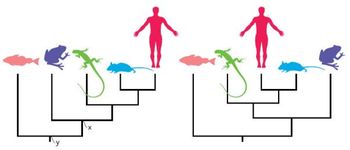
BIOLOGY:CONCEPTS+APPL.(LOOSELEAF)
10th Edition
ISBN: 9781305967359
Author: STARR
Publisher: CENGAGE L
expand_more
expand_more
format_list_bulleted
Question
These trees present the same hypothesis.
true or false

Expert Solution
This question has been solved!
Explore an expertly crafted, step-by-step solution for a thorough understanding of key concepts.
This is a popular solution
Trending nowThis is a popular solution!
Step by stepSolved in 2 steps

Knowledge Booster
Similar questions
- Please help me answer number 1 d and number 2 2.1 a,b,c and 2.2arrow_forwardTrue or false? All traits are inherited in a Mendelian pattern.arrow_forwardThis my third time posting the same question. Because no one answer it straight to me. Could you please tell me which of these choices is correct and Why.arrow_forward
- Global climate change is expected to result in drastic changes in precipitation patterns. This might mean that, due to the rain shadow effect, the windward sides of mountains might be wetter, while the leeward sides of mountains might be drier. Using what you know about plant taxonomy and ecological relationships, propose a justified, ecological hypothesis on how plant community composition would change on each side of the mountain. Your answer should contain two parts: The hypothesis and the ecological justification addressing the bold points above.arrow_forwardneed helparrow_forwardHeritability is valid for (select all that apply)? a-No answer text provided. b-No answer text provided. c-Multiple populations of a species d-Single populations of a species e-Any environment f-Any point in time g-A specific point in timearrow_forward
- Can you please make a conclusion for this? Thank you so much! Suppose you counted 79 R_ and 33 rr. The total number of individuals you counted, N, is 112. You expect 3/4 to be R_ (84) and 1/4 to be rr (28). Are your results close enough to these ratios for you to accept the null hypothesis—that there is no real difference? Individual'sPhenotype Observed number Observed Ratio Expected Ratio Expected Number (Observed no. – Expected no.)^2 / Expected number R_ 79 2.8 3 84 (79-84) ^2 = 25/84 = 0.297 rr 33 1.18 1 28 (33-28) ^2 = 25/28 = 0.893 TOTAL: 112 Chi Square Value = 1.19 Degrees of freedom = 1arrow_forwardKeeping Mendel's experiment in mind. Define law of probability and provide an example.arrow_forwardplease help me with this questionarrow_forward
- Discuss the concept of the null hypothesis and its use indata analysis.arrow_forwardDesign a simple, manipulative experiment to test the hypothesis that synthetic fertilizers in the environment influence the population density of the salamander, Ambystoma tigrinum. Your experiment can have no fewer than two treatments and no more than four. State your hypothesis. Briefly describe your experiment. Address the following: Is it a field or lab experiment? What are the treatments, how are they set up, and what differentiates them? How many replicates of each treatment will there be? What are the standardized conditions of your experiment? C. Identify the independent variable, including units, in your experiment. D. Identify the dependent variable, including units, in your experiment. E. Identify at least one control treatment and explain its specific role in the experiment.arrow_forwardCan you help me to find answers thank you so much.arrow_forward
arrow_back_ios
SEE MORE QUESTIONS
arrow_forward_ios
Recommended textbooks for you

 Biology Today and Tomorrow without Physiology (Mi...BiologyISBN:9781305117396Author:Cecie Starr, Christine Evers, Lisa StarrPublisher:Cengage Learning
Biology Today and Tomorrow without Physiology (Mi...BiologyISBN:9781305117396Author:Cecie Starr, Christine Evers, Lisa StarrPublisher:Cengage Learning Biology 2eBiologyISBN:9781947172517Author:Matthew Douglas, Jung Choi, Mary Ann ClarkPublisher:OpenStax
Biology 2eBiologyISBN:9781947172517Author:Matthew Douglas, Jung Choi, Mary Ann ClarkPublisher:OpenStax


Biology Today and Tomorrow without Physiology (Mi...
Biology
ISBN:9781305117396
Author:Cecie Starr, Christine Evers, Lisa Starr
Publisher:Cengage Learning

Biology 2e
Biology
ISBN:9781947172517
Author:Matthew Douglas, Jung Choi, Mary Ann Clark
Publisher:OpenStax
